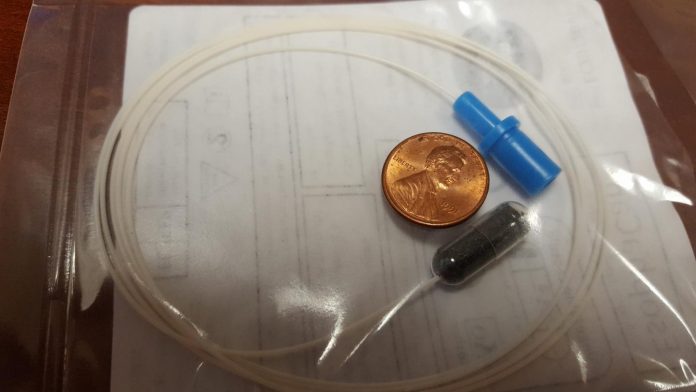A new screening method that uses a sponge-on-a-string device could help save lives by detecting Barrett’s esophagus, a precursor to esophageal cancer.
Esophageal cancer has a poor survival rate. It is the eighth most common cancer and sixth most common cancer-related cause of death. The only known precursor to esophageal cancer is Barrett’s esophagus (BE), a condition where normal tissue that lines the esophagus is replaced by abnormal cells that can become cancerous. Although the actual risk of developing esophageal cancer from Barrett’s esophagus is low, monitoring is recommended as there are better patient outcomes in those who do go on to develop esophageal cancer.
Current screening methods lack efficacy in detecting Barrett’s esophagus
Current screening methods that focus on patients with acid reflux disease lack efficacy in detecting Barrett’s esophagus. Only one-third of patients who are diagnosed with Barrett’s esophagus report a history of acid reflux, thus suggesting that this screening strategy misses a significant number of patients with Barrett’s esophagus. As a result, new methods to screen for Barrett’s esophagus have been explored. Researchers from the USA and China studied the safety, feasibility and efficacy of the EsophaCap to screen for Barrett’s esophagus and published their results in Clinical Cancer Research.
New method involves swalllowing a sponge capsule
EsophaCap is a swallowable capsule sponge device attached to a string that can retrieve cellular samples from the esophagus. The patient swallows the capsule while the string is held outside the mouth. In the stomach, the capsule dissolves to release a sponge that expands and picks up cells from the esophagus as it exits the body when the string is pulled on.
The researchers conducted their study to evaluate the EsophaCap in 80 patients. A total of 85% of patients swallowed the EsophaCap successfully, and 100% of those successfully retrieved the sponge. No adverse events were reported with using EsophaCap in any of the subjects.These cell samples were then analyzed using a methylation on beads (MOB) technique that can analyze DNA from a small cell sample.
Eight genes that are implicated in Barrett’s esophagus, were examined and compared between patients diagnosed with Barrett’s esophagus and control patients. Not only did the EsophaCap demonstrate its safety and efficacy in retrieving cell samples, but the methylation on beads technique for analyzing the DNA was also found to be more sensitive than traditional DNA extraction methods and is a reliable method of diagnosis.
EsophaCap is easy, cost-effective, and minimally invasive
Current endoscopy screening methods are expensive and unreliable at detecting Barrett’s esophagus. This study demonstrates that the EsophaCap is an easy, safe, cost-effective, and minimally invasive tool to sample esophageal cells. In combination with the methylation on beads DNA analyzing technique, this could be a promising new strategy to screen for Barrett’s esophagus in patients and thus improve esophageal cancer outcomes. The positive results from this study highlight the need for future studies done in larger populations.
Written by Maggie Leung, PharmD
References
- Wang, Z., Kambhampati, S., Cheng, Y., Ma, K., Simsek, C., Tieu, A. H., . . . Meltzer, S. J. (2019). Methylation Biomarker Panel Performance in EsophaCap Cytology Samples for Diagnosing Barretts Esophagus: A Prospective Validation Study. Clinical Cancer Research. doi:10.1158/1078-0432.ccr-18-3696
- Smith, P. (2019, January 22). Test for esophageal cancer could save millions of lives. Retrieved February 2, 2019, from https://www.eurekalert.org/pub_releases/2019-01/jhm-tfe012219.php
- Image source: https://www.eurekalert.org/multimedia/pub/190842.php?from=418185



